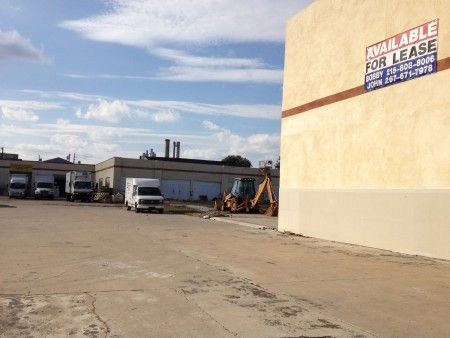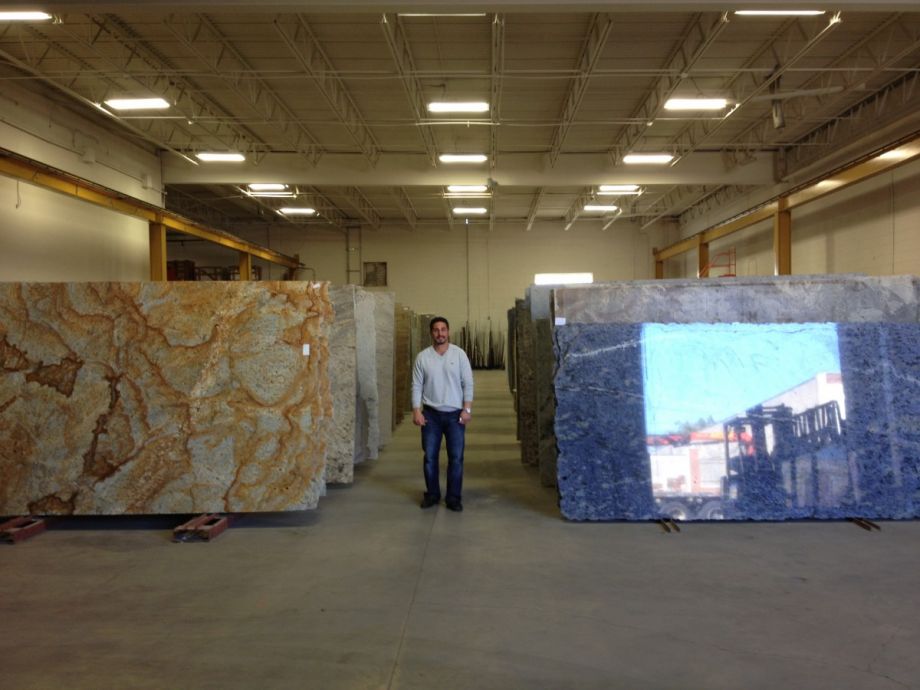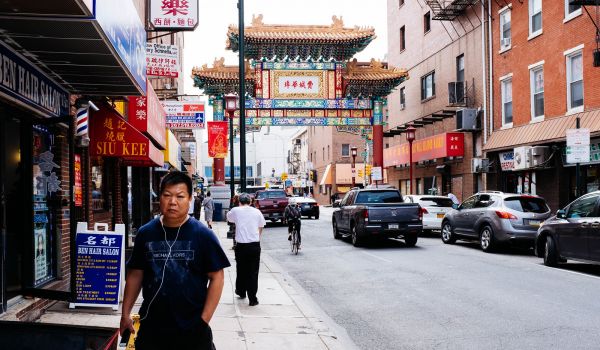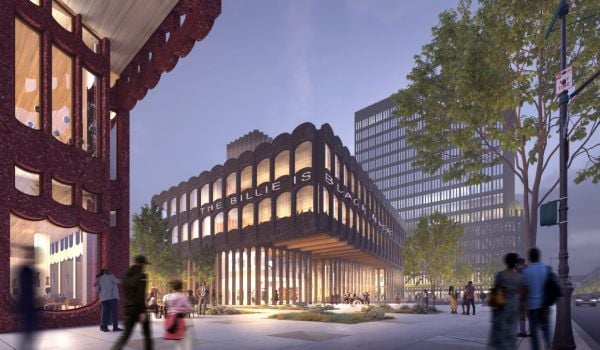This is the third and final article in a short series about the changing identity of the Washington Avenue corridor in South Philadelphia. Read the first two installments here and here.
Dressed in a Lacoste shirt and Diesel jeans, Michael Mazolla dashes upstairs to the office of his 50,000-square-foot warehouse. His company, CAVA International, has imported and sold granite and marble on Washington Avenue for over 40 years. Mazolla proudly points out stone from origins as distant as Brazil and Bali. The showroom leads to an even bigger storeroom equipped with a crane to lift the slabs and a processing shop where workers cut blocks amid a shower of sparks.
East of Broad Street, South Philadelphia’s Washington Avenue bustles with foot traffic, but the western part of the corridor maintains a more industrial feel. Design warehouses have proliferated in recent years as owners have subdivided properties and rented them out. Now, “pretty much everything you can get at Home Depot you can buy on the avenue,” says Andrew Dalzell of the South of South Neighborhood Association. “Washington Avenue builds Philadelphia.”
Mazolla waxes poetically about his dreams for Washington. “I had a vision of keeping it kind of like the Avenue of the Arts,” he says, “I had the vision of keeping Washington Avenue the construction hub for Philadelphia.” His store, modern and clean and contrasting with the dust and shabby signs on the surrounding warehouses, is the down payment he put on that dream.
“There’s a few people that have really put the investment back into the avenue, and maybe it was premature,” Mazolla says. “We thought that we would be here forever.”
Capitalizing on already-present businesses and rebranding the avenue as a design hub is one potential plan for future, according the Laura Stina at the City Planning Commission. The designation would build on the avenue’s industrial legacy — something that the Philadelphia Industrial Development Corporation (PIDC), a key player in the conversation, is pushing.
PIDC was created in 1958 to promote industry and economic development. It runs a land bank of industrial property, but is also an active participant in land use and planning discussions due to its lengthy experience with industry. PIDC advocates the protection of industrial land in the city, pointing to its economic benefits: PIDC calculated that 20 percent of the city’s present day jobs are in industry.
“Post-industrial is a misnomer for Philadelphia,” said Tom Dalfo, vice president of real estate services at PIDC, responding to the common characterization of Philadelphia. “It’s certainly not what it was in the 1940s or ’50s or ’60s, but it’s still an important part of the overall economy.”
In a 2010 report, PIDC recommended the creation of industrial mixed-use zoning designations. It labeled Washington Avenue an industrial area “in transition,” noting that it is small, surrounded by residential neighborhoods and architecturally unfit for modern industry. Philadelphia’s new zoning code includes designations for industrial-residential-mixed-use and industrial-commercial-mixed-use, and Dalfo said Washington Avenue is one of a few areas that make sense for the designation.
“With the mix of industrial and commercial uses,” he said, “it would recognize the fact that either [Washington Avenue] no longer functions or isn’t likely to continue to function as a cohesive industrial corridor.”
But mixed use means diverse neighbors, and, as Mazolla can attest, the encroachment of surrounding neighborhoods on Washington Avenue has not been without conflict. Mazolla bought a lot full of dilapidated homes just off the avenue in 2004, intending to build a wholesale warehouse and expand the design business — a move in line with the rebranding project. But, he says, “the neighbors didn’t want it,” and his application to change the zoning from residential to industrial was denied. Instead, he built homes that he says sold for $400,000-$500,000.
Now, new neighbors — educated, wealthy and living in homes of the sort Mazolla built — clash with the industrial rhythm of the avenue. “Once they are there and at six in the morning they hear the rumbling, they become more vocal,” Mazolla says. “But yeah, they knew what they had here and they bought homes anyway.”
The South of South Neighborhood Association, meanwhile, is pushing to make the neighborhood more walkable and to fill Washington Avenue with businesses residents will need. “It is a corridor with immense potential because you can put uses there that you can’t put elsewhere,” says Dalzell. “Anything from a bank to a music venue to a bowling alley to a plant nursery.”

Much of Washington Avenue remains highly industrial. Credit: Allyn Gaestel
Tom Donatucci of Donatucci Kitchens, another longtime family business on the avenue, is ready to ditch the industrial design project and cater to the gentrifying neighborhoods. “Fifteen years from now, you will see this burgeoning… I was hoping for 10, it might be five! It is that hot,” he says. “What is happening is it is Rittenhouse Square south, it is exploding.” Rittenhouse Square, Philadelphia’s wealthy shopping district, is less than a mile north. The neighborhood in between, Graduate Hospital, has been witness to a speedy face-lift as row homes are rehabilitated and property values soar.
“Those neighborhoods need to be served and they don’t need my business — kitchen business, tile business and the like,” Donatucci said. He is pushing for commercial and residential mixed use and development. He sees potential for projects bigger than he could ever finance.
While sad to watch the slow disintegration of his own dream for the avenue, Mazolla agrees that the space could hold more lucrative businesses. “See,” he says, “the bricks here have become more valuable than the business.”
The question remains, though, how to get from the chaotic, semi-industrial landscape of today to the mixed use of the business owners’ dreams, “Everybody agrees what is best, but that is chasing 15 years, 10 years, five years, three years,” says Donatucci, who serves as secretary of the Washington Avenue Property Owner’s Association. “But you have to feed your family tomorrow.”
Planners say it is likely that West Washington Avenue will be zoned industrial mixed use in the Central District plan. But what that designation means, and how to manifest it in a way that embraces both an industrial history and a gentrifying future, is a nagging question for the actors involved. The Red Hook neighborhood in Brooklyn could prove inspirational: There, a mixed-use zone has become a truly mixed community that links the industrial with the hip.
Red Hook has seen a 60 percent increase in businesses since 1991, according to the Southwest Brooklyn Industrial Development Corporation. On its website SBIDC states, “Red Hook’s central location and abundance of M-zoned land have been pivotal in Red Hook’s recent industrial resurgence.”
The key factors linked to Red Hook’s resurgence parallel Washington Avenue’s potential. Heading toward mixed-use zoning, and within walking distance from Center City, Washington Avenue could be reimagined in a similar way.
A new industrial design center called NextFab Studio plans on relocating to Washington Avenue from West Philly in December, and could signify a step in that direction. The self-described “membership-based, high-tech workshop and prototyping center” sounds like it would be at home in a place like Red Hook, and developers hope will bring “a new light” to Washington Avenue.
The question remains, however, of how industrial design spaces will mesh with the service industries that new neighbors crave. Three years ago a writer on the Philadelphia Speaks online forum was already voicing concerns about the pie-in the-sky projections for Washington Avenue: “Sigh. I have a feeling that when I eventually move out of my house (5-10 years), the realtors who show it will still be saying, “and that old factory there might become a Trader Joe’s really soon!” (SIC)
Despite his optimism, Donatucci acknowledges the bumps in the road to the avenue he sees so clearly. “The question is,” he says, “are we dreaming?”

Allyn Gaestel is currently a Philadelphia Fellow for Next City. Much of her work centers on human rights, inequality and gender. She has worked in Haiti, India, Nepal, Mali, Senegal, Democratic Republic of Congo and the Bahamas for outlets including the Philadelphia Inquirer, the Los Angeles Times, Reuters, CNN and Al Jazeera. She tweets @allyngaestel.
















